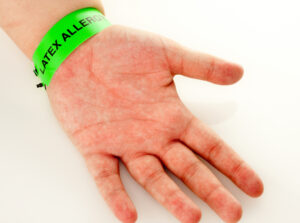November 08, 2022 | Black & Kletz Allergy

Latex allergy is a condition in which a sensitive individual develops an immunological reaction against the allergenic proteins found in natural rubber latex. This allergic reaction usually begins within 30 minutes, but can develop later, and can range in severity from mild to life-threatening. Approximately 1-2% of the U.S. population has a latex allergy. Latex allergies are much more common in certain groups of individuals such as children with spina bifida, rubber industry workers, patients who have had multiple surgeries, patients who have had recurrent catheterizations of their bladder, and health care workers.
Approximately 70% of children with spina bifida have latex allergies because they have not one but 2 risk factors for latex allergies: multiple surgical procedures and the use rubber urinary catheters. Both of these factors make these children more susceptible to latex allergy mainly because they come in contact with natural rubber latex more than most individuals. Since they are exposed to latex more than the average person, they are more likely to develop an allergy to latex.
The allergic reaction that occurs in an individual due to a latex allergy can be different in each person. The allergic reaction can be either an immediate-type (i.e., Type I) hypersensitivity reaction or a delayed-type (i.e., Type IV) hypersensitivity reaction. In addition to a true allergic reaction, a non-allergic irritant contact dermatitis may also occur. In an immediate-type or Type I allergic reaction, the allergic individual usually has allergy symptoms within 30 minutes after exposure to the allergen (i.e., mold, dust mite, pollen, food, bee venom). The allergic reactions to latex usually occur after a number of exposures to latex, however, the severity of the reactions can worsen with repeated exposures. The symptoms of an immediate-type (Type I) allergic reaction due to a latex allergy may include sneezing, runny nose, nasal congestion, post-nasal drip, itchy eyes, watery eyes, redness of the eyes, wheezing, shortness of breath, chest tightness, coughing, generalized itching, hives (i.e., urticaria), abdominal cramping, throat tightening (i.e., angioedema), nausea, dizziness, rapid heart rate, feeling faint, and/or drop in blood pressure. In severe cases, anaphylaxis can occur which can be life-threatening. A self-injectable epinephrine device may be prescribed to an individual with a history of a systemic reaction to latex. If such a device is used, they are to go immediately to the closest emergency room.
Physical contact with latex can also cause soreness and blistering of the skin which usually begins 2 to 3 days of exposure. This type of reaction is a delayed-type (Type IV) reaction and is called allergic contact dermatitis. It is similar to the reaction that is caused by poison ivy, poison oak, and poison sumac. As mentioned above, a non-allergic irritant contact dermatitis may also occur. Patients with this type of reaction may develop itchy, red, dry, flaky, peeling, and/or cracked skin after topical exposure to latex. Blisters may also develop in certain individuals.
The diagnosis of latex allergy is made by a comprehensive history and physical examination. Blood tests can be done to confirm a diagnosis. Allergy skin testing can also be performed in individuals where the blood test is negative but there is a high index of suspicion for latex allergy.
The treatment of latex allergy is to avoid exposure to natural rubber latex. Individuals should avoid all products containing latex, some of which may include: latex gloves, condoms, dental dams, balloons, rubber bands, select toys, tires, erasers, elastic clothing waistbands, nipples used on baby bottles, pacifiers, baby bottles, soles of shoes, athletic shoes, certain fruits and vegetables (see below). Many medical and dental devices (e.g., gloves, stethoscopes, dental dams, catheters, and airway and IV tubing. It should be noted that synthetic rubber products such as house paint are not made with natural latex. Patients who are allergic to latex should wear a medical alert bracelet and carry a self-injectable epinephrine device (e.g., EpiPen, Auvi-Q, Adrenaclick) and know when to use it. As mentioned above, if the self-injectable epinephrine device is used, the individual should go immediately to the closest emergency room.
It should also be noted that certain fruits and vegetables cross-react with latex as they share similar proteins and should be avoided in individuals who have a latex allergy. Approximately 30-50% of people with latex allergy have reactions to these fruits and vegetables. Some of the more common cross-reacting fruits and vegetables may include apples, avocados, bananas, chestnuts, carrots, celery, kiwi, melons, papayas, potatoes, and tomatoes.
The board certified allergists at Black and Kletz Allergy have over 50 years of experience in diagnosing and treating latex allergies. We treat both pediatric and adult patients. Black & Kletz Allergy has 3 convenient locations with on-site parking located in Washington, DC, McLean, VA (Tysons Corner, VA), and Manassas, VA. The Washington, DC and McLean, VA offices are Metro accessible and we offer a free shuttle that runs between the McLean, VA office and the Spring Hill metro station on the silver line. To schedule an appointment, please call any of our offices or you may click Request an Appointment and we will respond within 24 hours by the next business day. We have been servicing the greater Washington, DC metropolitan area for many decades and we look forward to providing you with the utmost state-of-the-art allergy care in a warm and pleasant environment.












